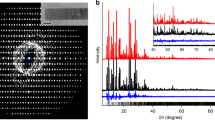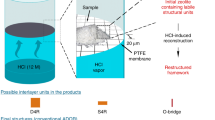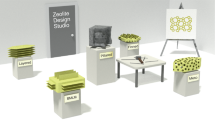Abstract
The prediction and synthesis of new crystal structures enable the targeted preparation of materials with desired properties. Among porous solids, this has been achieved for metal–organic frameworks1,2,3, but not for the more widely applicable zeolites4,5, where new materials are usually discovered using exploratory synthesis. Although millions of hypothetical zeolite structures have been proposed6,7, not enough is known about their synthesis mechanism to allow any given structure to be prepared. Here we present an approach that combines structure solution with structure prediction, and inspires the targeted synthesis of new super-complex zeolites. We used electron diffraction to identify a family of related structures and to discover the structural ‘coding’ within them. This allowed us to determine the complex, and previously unknown, structure of zeolite ZSM-25 (ref. 8), which has the largest unit-cell volume of all known zeolites (91,554 cubic ångströms) and demonstrates selective CO2 adsorption. By extending our method, we were able to predict other members of a family of increasingly complex, but structurally related, zeolites and to synthesize two more-complex zeolites in the family, PST-20 and PST-25, with much larger cell volumes (166,988 and 275,178 cubic ångströms, respectively) and similar selective adsorption properties. Members of this family have the same symmetry, but an expanding unit cell, and are related by hitherto unrecognized structural principles; we call these family members embedded isoreticular zeolite structures.
This is a preview of subscription content, access via your institution
Access options
Subscribe to this journal
Receive 51 print issues and online access
$199.00 per year
only $3.90 per issue
Buy this article
- Purchase on Springer Link
- Instant access to full article PDF
Prices may be subject to local taxes which are calculated during checkout




Similar content being viewed by others
Change history
05 August 2015
NaTEA-ZSM-25 was corrected to NaSrTEA-PST-20 in the Methods section.
References
Yaghi, O. M. et al. Reticular synthesis and the design of new materials. Nature 423, 705–714 (2003)
Eddaoudi, M. et al. Systematic design of pore size and functionality in isoreticular MOFs and their application in methane storage. Science 295, 469–472 (2002)
Deng, H. et al. Large-pore apertures in a series of metal-organic frameworks. Science 336, 1018–1023 (2012)
Davis, M. E. Ordered porous materials for emerging applications. Nature 417, 813–821 (2002)
Wang, Z., Yu, J. & Xu, R. Needs and trends in rational synthesis of zeolitic materials. Chem. Soc. Rev. 41, 1729–1741 (2012)
Foster, M. D. & Treacy, M. M. J. Atlas of Prospective Zeolite Structures http://www.hypotheticalzeolites.net/ (2010)
Deem, M. W. Deem Database http://www.hypotheticalzeolites.net/DATABASE/DEEM/index.php (2011)
Doherty, H. G., Plank, C. J. & Rosinski, E. J. Crystalline zeolite ZSM-25. US patent 4,247,416 (1981)
Férey, G. Building units design and scale chemistry. J. Solid State Chem. 152, 37–48 (2000)
Zou, X. D., Conradsson, T., Klingstedt, M., Dadachov, M. S. & O’Keeffe, M. A mesoporous germanium oxide with crystalline pore walls and its chiral derivative. Nature 437, 716–719 (2005)
Lin, H.-Y. et al. Crystalline inorganic frameworks with 56-ring, 64-ring, and 72-ring channels. Science 339, 811–813 (2013)
Willhammar, T., Yun, Y. F. & Zou, X. D. Structure determination: structural determination of ordered porous solids by electron crystallography. Adv. Funct. Mater. 24, 182–199 (2014)
Zou, X. D., Hovmöller, S. & Oleynikov, P. Electron Crystallography: Electron Microscopy and Electron Diffraction Ch. 9 (Oxford Univ. Press, 2011)
Gramm, F. et al. Complex zeolite structure solved by combining powder diffraction and electron microscopy. Nature 444, 79–81 (2006)
Baerlocher, C. et al. Structure of the polycrystalline zeolite catalyst IM-5 solved by enhanced charge flipping. Science 315, 1113–1116 (2007)
Baerlocher, C. et al. Ordered silicon vacancies in the framework structure of the zeolite catalyst SSZ-74. Nature Mater. 7, 631–635 (2008)
Zhang, D. L., Oleynikov, P., Hovmöller, S. & Zou, X. D. Collecting 3D electron diffraction data by the rotation method. Z. Kristallogr. 225, 94–102 (2010)
Wan, W., Sun, J. L., Su, J., Hovmöller, S. & Zou, X. D. Three-dimensional rotation electron diffraction: software RED for automated data collection and data processing. J. Appl. Crystallogr. 46, 1863–1873 (2013)
Willhammar, T. et al. Structure and catalytic properties of the most complex intergrown zeolite ITQ-39 determined by electron crystallography. Nature Chem. 4, 188–194 (2012)
Martínez-Franco, R. et al. Synthesis of an extra-large molecular sieve using proton sponges as organic structure-directing agents. Proc. Natl Acad. Sci. USA 110, 3749–3754 (2013)
Hua, W. et al. A germanosilicate structure with 11×11×12‐ring channels solved by electron crystallography. Angew. Chem. Int. Edn 53, 5868–5871 (2014)
Zhang, H., Zou, X. D., Oleynikov, P. & Hovmöller, S. Structure relations in real and reciprocal space of hexagonal phases related to i-ZnMgRE quasicrystals. Phil. Mag. 86, 543–548 (2006)
Hong, S. B. et al. Synthesis and characterization of zeolite ZSM-25. Stud. Surf. Sci. Catal. 135, 186 (2001)
Baerlocher, Ch. & McCusker, L. B. Database of Zeolite Structures http://www.iza-structure.org/databases/ (2007)
Karle, J. & Karle, I. L. The symbolic addition procedure for phase determination for centrosymmetric and non-centrosymmetric crystals. Acta Crystallogr. 21, 849–859 (1966)
Vaughan, D. E. W. & Strohmaier, K. G. Synthesis of ECR-18—a synthetic analog of paulingite. Micropor. Mesopor. Mat. 28, 233–239 (1999)
Blatov, V. A., Ilyushin, G. D., Lapshin, A. E. & Golubeva, O. Yu. Structure and chemical composition of the new zeolite ISC-1 from the data of nanocluster modeling. Glass Phys. Chem. 36, 663–672 (2010)
Rochelle, G. T. Amine scrubbing for CO2 capture. Science 325, 1652–1654 (2009)
Shang, J. et al. Discriminative separation of gases by a “molecular trapdoor” mechanism in chabazite zeolites. J. Am. Chem. Soc. 134, 19246–19253 (2012)
Lozinska, M. M. et al. Cation gating and relocation during the highly selective “trapdoor” adsorption of CO2 on univalent cation forms of zeolite Rho. Chem. Mater. 26, 2052–2061 (2014)
Totktarev, A., Harris, T., Kibby, C., Ione, K. & O'Rear, D. Studies on ZSM-25. In Proc. 12th Int. Zeolite Conf. Vol. 1 (eds Treacy, M. M. J. et al.) 2023–2030 (Materials Research Society, Cambridge Univ. Press, 1999)
Chatelain, T. et al. Synthesis and characterization of high-silica zeolite RHO prepared in the presence of 18-crown-6 ether as organic template. Microporous Mater. 4, 231–238 (1995)
Coe, C. G., Gaffney, T. R. & Srinivasan, R. S. Chabazite for gas separation. US patent 4,925,460 (1990)
Sheldrick, G. M. A short history of SHELX. Acta Crystallogr. A64, 112–122 (2008)
Gordon, E. K., Samson, S. & Kamb, W. B. Crystal structure of the zeolite paulingite. Science 154, 1004–1007 (1966)
Palatinus, L. & Chapuis, G. SUPERFLIP – a computer program for the solution of crystal structures by charge flipping in arbitrary dimensions. J. Appl. Crystallogr. 40, 786–790 (2007)
Palatinus, L., Prathapa, S. J. & van Smaalen, S. EDMA: a computer program for topological analysis of discrete electron densities. J. Appl. Crystallogr. 45, 575–580 (2012)
Young R. A., (ed.) The Rietveld Method (Oxford Univ. Press, 1995)
Le Bail, A., Duroy, H. & Fourquet, J. L. Ab-initio structure determination of LiSbWO6 by X-ray powder diffraction. Mater. Res. Bull. 23, 447–452 (1988)
Larson, A. C. & Von Dreele, R. B. General Structure Analysis System (GSAS). Report No. LAUR 86-748 (Los Alamos National Laboratory, 2004)
Henson, N. J., Cheetham, A. K. & Gale, J. D. Theoretical calculations on silica frameworks and their correlation with experiment. Chem. Mater. 6, 1647–1650 (1994)
Acknowledgements
We acknowledge financial support from the Swedish Research Council (VR), the Swedish Governmental Agency for Innovation Systems (VINNOVA), the Röntgen-Ångström Cluster through the project grant MATsynCELL, the Knut and Alice Wallenberg Foundation through the project grant 3DEM-NATUR, the NCRI (2012R1A3A-2048833) and BK 21-plus programmes through the National Research Foundation of Korea, and the UK EPSRC (EP/J02077X/1). We acknowledge the ESRF, Grenoble (ID31, A. N. Fitch; ID22, C. Drathen) and the PAL, Pohang (9B, D. Ahn) for synchrotron X-ray beam time. We thank L. B. McCusker and C. Baerlocher for suggestions about the Rietveld refinement. The TEM was financed by the Knut and Alice Wallenberg Foundation.
Author information
Authors and Affiliations
Contributions
S.B.H. and P.A.W. identified and initiated the research project, which was developed and brought to a conclusion jointly by S.B.H., P.A.W. and X.Z. J.Sh., J.G.M., H.J.C. and S.B.H. carried out the zeolite synthesis and gas sorption work. P.G. conducted the TEM work. P.G., L.L. and X.Z. carried out the structure solution and structure prediction work. P.G., A.G.G., J.Su, P.A.W. and X.Z. made the Rietveld refinements. P.A.C. did the molecular modelling and energy calculations. P.G., J.Sh., S.B.H., P.A.W. and X.Z. wrote and corrected the manuscript.
Corresponding authors
Ethics declarations
Competing interests
The authors declare no competing financial interests.
Additional information
The Crystallography Information Files (CIFs) are deposited at the Cambridge Crystallographic Data Centre (CCDC, http://www.ccdc.cam.ac.uk) with CCDC numbers: 1031577 for as-made NaTEA-ZSM-25, 1057085 for calcined NaTEA-ZSM-25, 1057832 for as-made NaSrTEA-PST-20 and 1039878 for Na+-exchanged NaSrTEA-PST-20.
Extended data figures and tables
Extended Data Figure 1 Characterization of ZSM-25 and PST-20 zeolites.
a, b, PXRD patterns (left panels), 27Al (middle panels) and 29Si (right panels) magic-angle spinning NMR spectra of as-made (bottom plots within each panel) and calcined (top plots within each panel) ZSM-25 (a) and PST-20 (b).
Extended Data Figure 2 Reconstructed 3D reciprocal lattice from the RED data.
a–c, NaTEA-ZSM-25 and d–f, NaSrTEA-PST-20. a, d, The 3D reciprocal lattice with the crystal inset. b, c, e, f, 2D slices cut from the reconstructed 3D reciprocal lattice showing the (hk0) plane (b, e), (hkh) (c) and  (f) reciprocal plane. The distributions of the strong reflections for NaTEA-ZSM-25 and NaSrTEA-PST-20 are similar to that of PAU.
(f) reciprocal plane. The distributions of the strong reflections for NaTEA-ZSM-25 and NaSrTEA-PST-20 are similar to that of PAU.
Extended Data Figure 3 Structure factor amplitudes and phases calculated from the structure models of RHO-G1 to RHO-G6.
The  reflections are shown. Reflections in red and blue have phases of 0° and 180°, respectively. The red, green and blue circles correspond to d-spacings of 1.0 Å, 1.6 Å and 3.0 Å, respectively. The frameworks are idealized in the pure SiO2 forms.
reflections are shown. Reflections in red and blue have phases of 0° and 180°, respectively. The red, green and blue circles correspond to d-spacings of 1.0 Å, 1.6 Å and 3.0 Å, respectively. The frameworks are idealized in the pure SiO2 forms.
Extended Data Figure 4 PXRD profiles for the Rietveld refinement of as-made and Na+-exchanged NaSrTEA-PST-20.
Top, as-made NaSrTEA-PST-20. Bottom, Na+-exchanged NaSrTEA-PST-20 (denoted NaTEA-PST-20). The observed, calculated and difference curves are shown in blue, red and black, respectively. The good agreement of observed and calculated data at high angles (inset) indicates that the framework structure is correct. The slight differences at lower angles are due to incomplete determination of the positions of all guest molecules/cations (X-ray wavelength λ = 0.40091 Å).
Extended Data Figure 5 The prediction of the RHO-family members RHO-G1 to RHO-G6 from the structure of PAU (RHO-G3).
The arrows indicate how the structures were predicted from their nearest generations. The 3D electron-density map of RHO-Gn (n = 4–6) was generated using the structure factors of strong reflections from RHO-G(n − 1), which allowed a 3D structure model of RHO-Gn to be built. The structures of RHO-G1 and RHO-G2 were obtained from RHO-G3 by model building.
Extended Data Figure 6 Tile representations of the structures of RHO-G1 to RHO-G6 in the RHO family.
The structure expansion operates at two levels: first, a pair of pau and d8r cages is inserted along each unit-cell edge (top) resulting in isoreticular expansion of the scaffold; and second, other cages are embedded (middle) in the inter-scaffold space. The resulting frameworks are denoted as ‘embedded isoreticular zeolite structures’ (bottom).
Supplementary information
Supplementary Information
This file contains Supplementary Discussion (including the location of TEA+ cations in NaTEA-ZSM-25 by computational modelling), Supplementary Figures 1–9 and Supplementary Tables 1–17. (PDF 2843 kb)
Supplementary Data 1
This file contains crystallographic information for as-made NaTEA-ZSM-25, calcined NaTEA-ZSM-25, as-made NaSrTEA-PST-20 and Na+-exchanged NaSrTEA-PST-20. (CIF 2951 kb)
Supplementary Data 2
This file contains crystallographic information for hypothetical RHO-G1 to RHO-G6. (CIF 61 kb)
Source data
Rights and permissions
About this article
Cite this article
Guo, P., Shin, J., Greenaway, A. et al. A zeolite family with expanding structural complexity and embedded isoreticular structures. Nature 524, 74–78 (2015). https://doi.org/10.1038/nature14575
Received:
Accepted:
Published:
Issue Date:
DOI: https://doi.org/10.1038/nature14575
This article is cited by
-
Comparison of 3D-cDFT and GCMC simulations for fluid–structure analysis in amorphous carbon nanoporous materials
Adsorption (2024)
-
High-throughput phase elucidation of polycrystalline materials using serial rotation electron diffraction
Nature Chemistry (2023)
-
Regulating adsorption performance of zeolites by pre-activation in electric fields
Nature Communications (2023)
-
Single-crystal structure determination of nanosized metal–organic frameworks by three-dimensional electron diffraction
Nature Protocols (2022)
-
3D-3D topotactic transformation in aluminophosphate molecular sieves and its implication in new zeolite structure generation
Nature Communications (2020)
Comments
By submitting a comment you agree to abide by our Terms and Community Guidelines. If you find something abusive or that does not comply with our terms or guidelines please flag it as inappropriate.



